Hello all. I hope this finds you safe and well.
Perhaps like me, you have been put into a more reflective state of mind by the Coronavirus outbreak. In some ways, it seemed an appropriate moment to reach out, yet at the same time I’m strangely silenced by what is happening around us. I’m almost embarrassed to release a comparatively insignificant update on a book while the world is reeling under something so much bigger. It feels uncomfortable drawing attention away from the frontlines.
And yet … another voice reminds me that the frontlines are not the only lines, that they must be supported, and that all our little contributions towards a normal world and a steady economy are going to be vital in this fight. So I’m offering my contribution, one little block in the wall. To all who are out there in the vital services, you have my respect, my gratitude, and my prayers.
With that mindset, let’s move on to book matters. If nothing else, I hope it provides a momentary distraction from all the chaos.
Looking back

The second part of last year was difficult. I’ve never before had to deal with that level of recurring burnout. I think I’d seen myself as a kind of camel, capable of traversing deserts if I set my mind to it. Turns out that I underestimated the desert and overestimated my reserves.
That fourth rewrite wasn’t mere typo correction. In some ways, there was more that went into it than any of the previous stages. It required gallons of daily creativity. I forced myself on with strict hours and daily page quotas, and when I fell short during a week, I pushed harder the next to try and make up for the shortfall. I knew my reserves were running low, but the idea was to get the book to the alpha readers and then take a break. A few hundred pages short, the camel dried out. I would sit behind the computer for hours, vaguely aware that there were problems on the page but unable to generate solutions for the most basic of them.
After seeing a few medical specialists, the message was clear. I’d driven myself to burnout. Around this time, I saw a TED talk that really hit home. I feel better after a hard day’s work so I tend to push for mileage even when exhausted – to “fill the unforgiving minute with sixty seconds worth of distance run”. For me, downtime needs to be earned. When the presenter described the results of too much work and not enough rest, she described me. It wasn’t the only source to remind me that when depleted, our ability to be creative or find creative solutions is sharply reduced, even nullified. I was advised to take several months off, but I pointed out that this would only increase stress levels because of the mounting pressure to get the book finished. So I came up with a different solution.
It was partly inspired by the neighbour’s decision to renovate. The return of screaming angle grinders and rattling jackhammers to my life worked in my favour by forcing me to search for an escape. I realised that while I simply couldn’t put the work aside for months and go on an extended vacation, I could, in a sense, do something better – I could visit the world of the story. Strictly speaking, the regions in the books are never inspired by real places, but rather seeded by the moods of many places and then built up from imagination.
One of the regions in which the second book spends much time is heavily blanketed in snow. While writing those chapters, I’d drawn from memories of mountain hikes and done a fair amount of research into the geography and conditions that would be in the setting I was building up, but I’d always felt I could do more. When I thought of travelling through snowy regions and writing from cabins, I thought of Canada. The angle grinders raised their voices in strident harmony and made the decision easy.
Traipsing texture through the pages
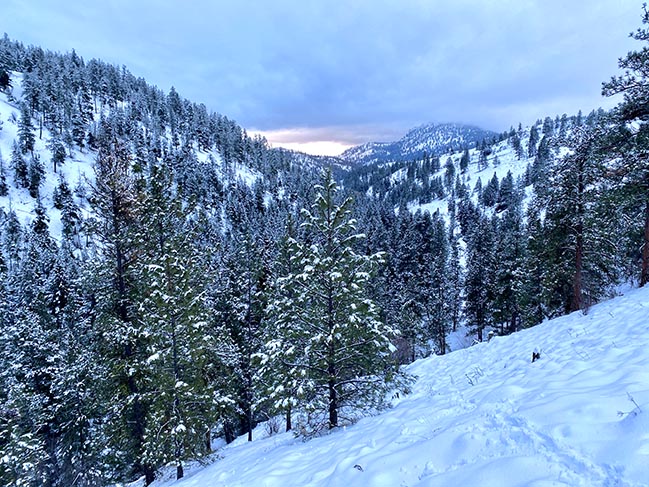
For the next two months, I travelled, mostly in British Columbia, writing through the days and heading out into the hills and forests for breaks and inspiration. I was careful about getting some rest time, but the freshness of the surroundings reimbursed my energy faster than I was spending it. Winter wonderlands are awe inspiring! Something of that inner child stirred and began pointing in all directions at once. “There! Go there! And there!”
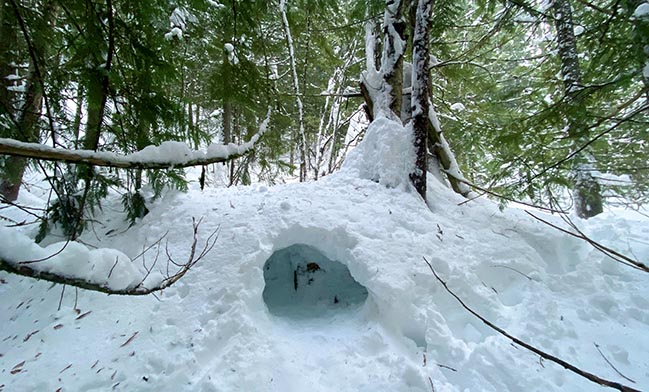
I said yes to everything. I did night hikes, built snow caves and emergency shelters, made fires with wet wood, and attempted to sleep out in damp clothes with no fire, no tent, no daylight prep time, and only a blanket for insulation after not eating for three days. The object was to deny myself the advantages that the characters in the book were being denied, but I hadn’t actually intended to deny myself so many advantages. The absence of fire was owing to the recent ice rain which had given the world more of a soaking than I’d imagined. I could almost wring out the firewood into my water bottle.
At some stage in the night I think I managed to pass into a kind of frozen coma for a few seconds. Does that count as “sleeping” out? If you’re wondering, I did finally make the call to hike back after a few hours when rattling teeth informed me that my thin blanket was never going to compensate for the damp layers beneath. Next time I won’t kneel on wet snow while digging and building my shelter. It’s amazing how moisture creeps all the way through non-waterproof fabric.
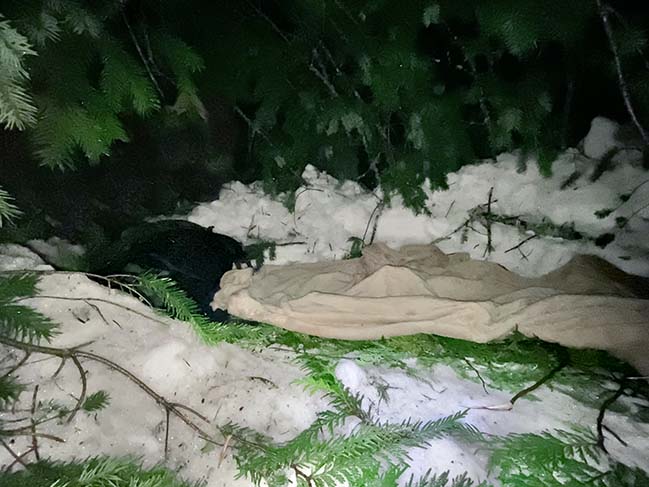
It wasn’t the most pleasurable experiment, but it certainly gave me a shockingly clear perspective on what I was putting my characters through. It was worlds apart from previous nights spent under the stars when I was at least armed with a sleeping bag. Sock drying, on the other hand, was as pleasurable as the other was painful. This time I headed out before dusk and had time to scrape off the slimy bark and feather my kindling. The firewood protested and spluttered, and it steamed even more than my socks, but after about half an hour the flames were victorious. That golden warmth was almost too delicious for words. Circumstances that push us to the edge really help us value the simple comforts in life.
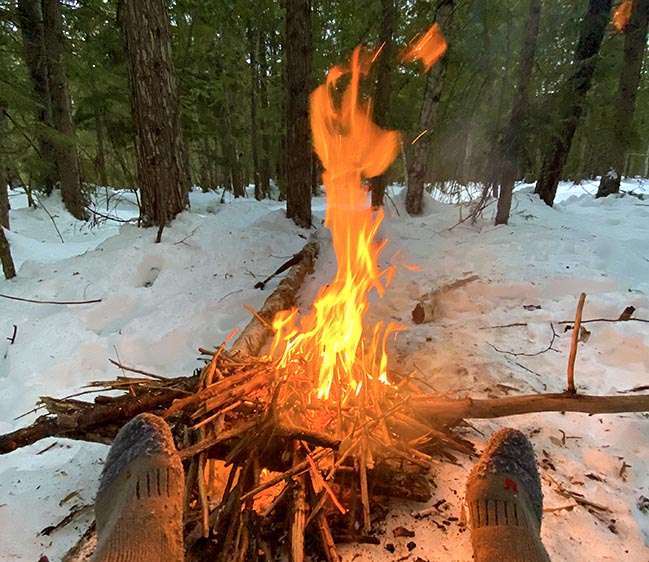
Spending several weeks in deep snow allowed me to try out various things in various conditions. Snow is the most diverse and fascinating substance. From dust in the wind to heavy sludge, it has such a range of characteristics that to represent it as a kind of uniform blanket, cold and white, isn’t much better than Baldrick defining the sea as a big blue wobbly thing. There are days when you can pull on boots and walk across a field of deep snow, the surface contributing little more than some musical crunching. But on other days the crust is weak and half of you suddenly disappears. Sometimes you end up plugged all the way down to your shoulders. You laboriously worm and clamber out, balance, try a few cautious steps, and vanish again. Covering fifty yards can take a very long time. Crawling helps, but you can’t keep that up for any great distance, and anyway you look ridiculous.
On one such day, I’d accepted the offer of my host’s snowshoes. He later described his nightmare of trying to creep over the crust without being swallowed alive – while a storm was breaking overhead. I’d had a long and carefree walk in the opposite direction – in his snowshoes. It left me with a curious conflict of gratitude and guilt.
The experiences brought home some of the limits of possibility, like how attempts to “move with the silence of a shadow” are feasible on some days but simply hilarious on others. There are ways to minimize noise, but without defying gravity there’s no silent drifting about for anyone when the conditions are super creaky.
There were also things I’d considered near impossible that turned out to be fairly straightforward. Moving through forests at night with overcast starlight (the darkest sky) is normally quite tricky, but when the ground is blanketed in white, the obstacles stand out clearly. Admittedly the white is more of a smudgy grey that my camera didn’t have a hope of exposing, but it’s enough to navigate by. When the moon is full, however, it’s almost like walking in daylight.
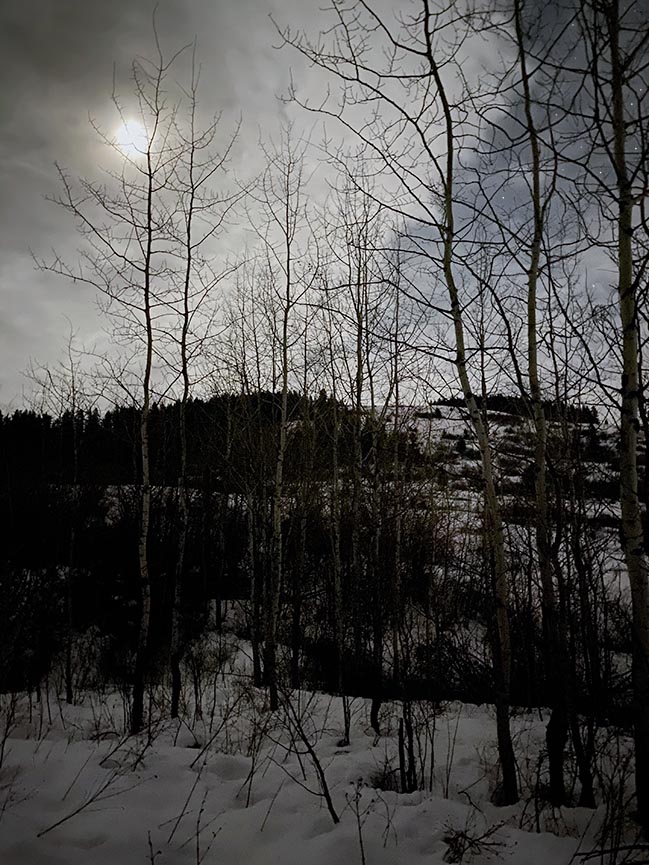
I’ve always loved night walks – without a torch which blinds you to everything outside the beam. It’s surprising how well you can see if you give your eyes a chance to adjust. During those weeks, I fell back into farm-boy ways. I climbed trees, tracked deer, sped down slopes in the dark on the world’s worst home-made toboggan (designed to match something in the book), skidded over all the black ice I could find, and generally behaved very responsibly. It was a time of de-stressing and refreshing the likes of which I haven’t had in years.
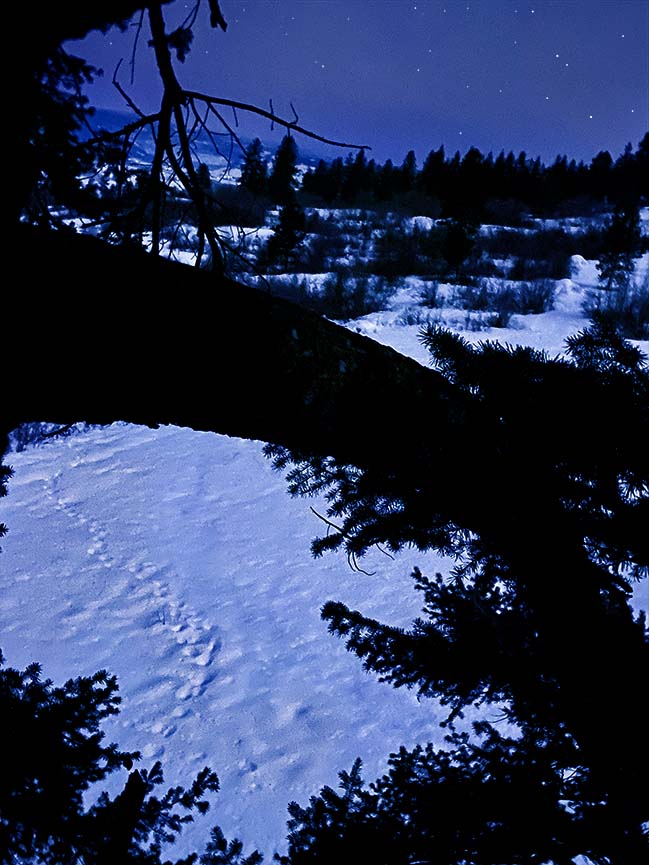
I learned that if you don’t feel like hiking back down the hill, a cheap windbreaker-type coat makes an excellent toboggan, provided the slope is steep. If the snow over the rugged ground isn’t thick enough, however, it’s considerably less enjoyable. When walking without snowshoes in fresh, waist-high snow, there is a special trick you can use to make yourself un-trackable.
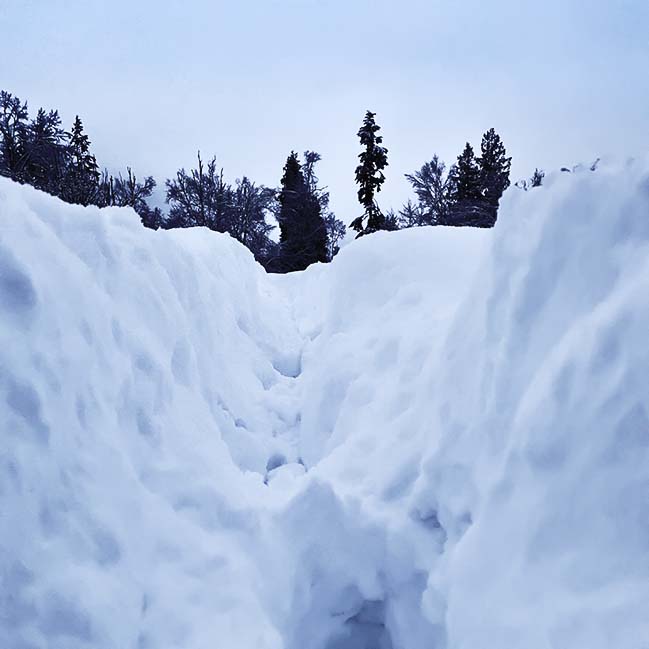
As you can see, the previous statement is, in fact, bunkum. Deep powder like this compresses as you move through it. There’s no covering the canyon that results when you’re wading rather than walking. There were other days, however, when boots would leave almost no impression in the same areas. Precipitation, sun, wind, and temperature are able to transform the terrain so quickly.
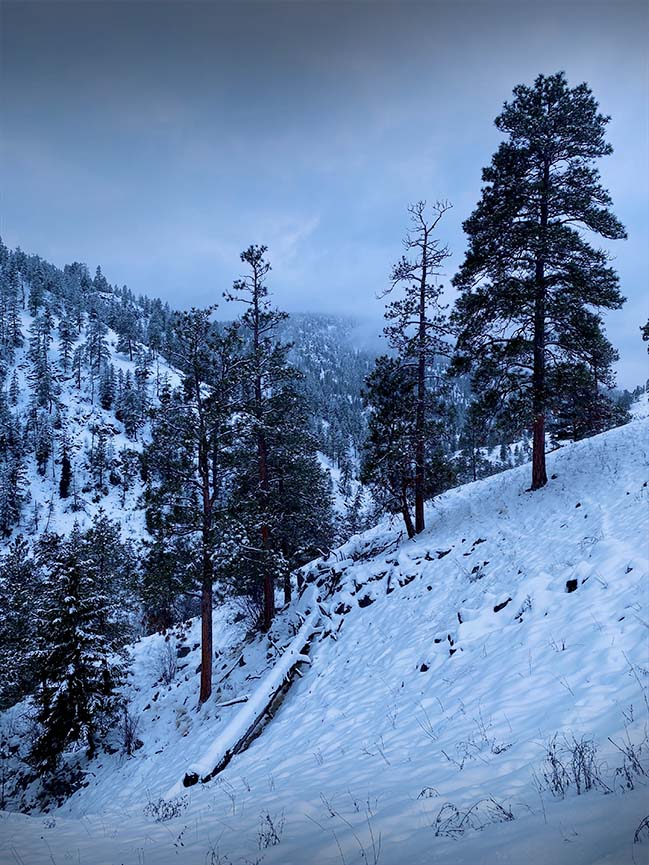
The icy walks, often draped in mist, were rich with inspiration, but the crown of many a day was a softly glowing fire. When my thoughts were unharnessed and allowed to wander through the flames, details I’d been gathering tended to animate themselves and lead me into stories of their own. Some of the best ideas grew from these long evenings of unstructured musing.
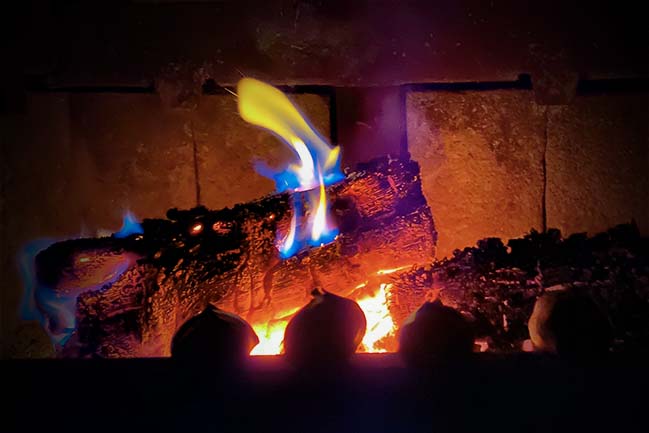
While out, I made constant voice notes, always searching for compelling details to build into the story. When back indoors, I worked the new textures in while fine-tuning or correcting the ones that were already there. Here’s one of my little writing stations. There were another ten of these at various points across several hundred miles, giving a fantastic range of forests, frozen lakes, hills, streams, and mountains.
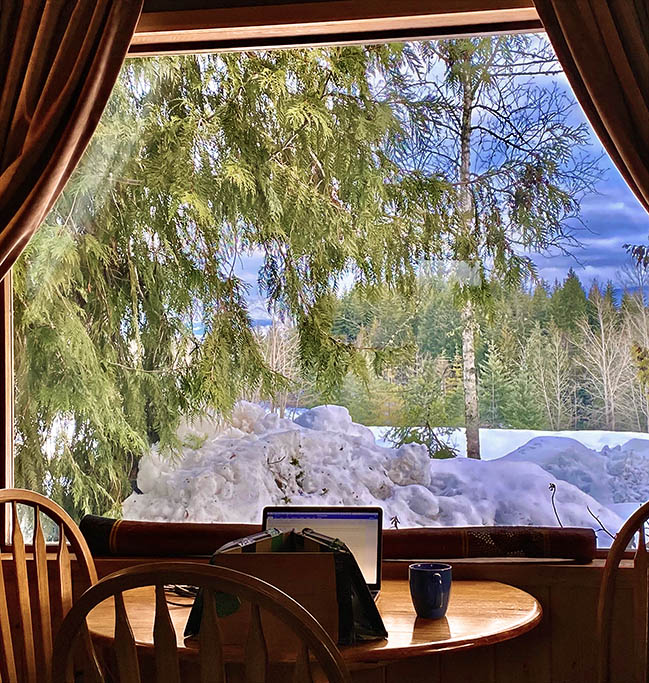
That weird block in front of the laptop is something I had to rig up to overcome the ache of tennis elbow from too much typing. I tried standard ergonomic keyboards, but none of them gave the needed relief. After about a year, the best option I discovered was to use a split keyboard and attach it to a home-made base. The result is something like a concertina, keys facing away from each other and slightly away from me. It took a bit of getting used to but this is the first time in three or four years that the tendons have been able to heal. It might not work for all, but it’s the only thing that worked for me. If you have the same issue and you’d like to give this a try, I’d be happy to send you a close up. Drop me a mail with “tennis elbow” in the subject. I’m not able to reply to all correspondence, but I’ll put a priority on this seeing as I know how debilitating it can be.
After about three months of work, the fourth rewrite was done and I’d been able to build in countless textures and some new plot-lines that necessarily grew from my discoveries. All this was sent to the alphas in addition to the pages they had been given earlier, and I was set to begin with feedback. But before I could start, there was an important hospital appointment.
A burden cut away.
Something that contributed heavily to last year’s burnout is a spinal condition I was born with. Until recently it was undiagnosed and very much in the background, but then it began a rapid advance. Two years ago I was training hard in various fighting styles (in large part so that I could write action scenes with more realism). Along with this, climbing, hiking, running and other activities were how I stayed healthy and worked off stress, but in recent months my spine got so bad that grocery shopping would make me lame. Eventually I had to put an end to all sport. In Canada I was mostly gritting my teeth to get around and I would pay for it with interest afterwards, but there was no way I was staying in my chair.
In terms of health, I fell a long way in the past few years. With chronic pain comes chronic fatigue, and with the inability to move comes an inability to work off stress. Accordingly, my stress levels and blood pressure rose to orbital levels. Surgical intervention, as any fellow sufferers will know, is not a decision you make lightly. Improvement is never guaranteed and there are serious risks. But this year my spine hit a critical point and the decision was more or less made for me. The operation, which happened just before the Corona lockdown, was successful. I’m still recovering, but I’m already able to stand without nerve pain. BP is back to normal, and there’s a marked feeling of release.
My hope is that this goes a long way to improving energy levels and productivity. Daily pain saps energy. Being freed of it is like having a dragging anchor cut away. There’s still a fair amount of tenderness from the operation and I’m not meant to be behind my desk for long hours, so I decided this would be a good opportunity to work on a blog article instead of taking the time off for convalescence.
Updates
I’m often asked why I don’t publish more regular updates. The reason is that updates only really make sense at the end of phase of development, and with a long book it takes a while to get through a phase. If I blogged several times in each phase, it would slow the book progress and would be as uninteresting as a builder giving weekly reports on a large project: Starting with the roof now. Still busy with the roof. Still the roof. The roof again. Another week on the roof … While working through a phase, I’m doing pretty much the same thing every day. It’s only when I reach the next stage that there’s a change of tack and content for an update.
In theory, I could get creative and write articles about non-related topics, but I keep coming back to something a friend once told me – “Put your main effort into your main work.” Over the past year, that advice really stood out in bold. I’ve chosen to spend a rough minimum of 95% of my workday on the book. It means that blogging, social media engagement, and emails take a back seat. I know it can be frustrating, but it does bring the release date nearer. I’m pretty sure that’s first prize for everyone.
The status of the book
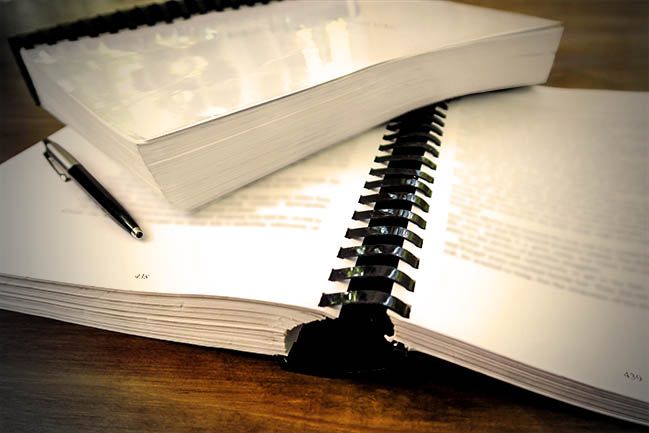
Here is what a proof reader copy looks like. It’s just over 450,000 words, 1200 pages split into two for the sake of manageability. This is one of my favourite points in the process – having a complete printout that I can hold. It’s the moment when it’s no longer just a digital project, but an actual book, even if it’s still in need of editing and polishing.
During rewrites, authors typically trim the manuscript, cutting out the bloat. This was an important part of the last rewrite. On the whole, the book became quite a bit leaner. Why then, you ask, is it longer than it was last year? When I blogged about the writing process, I mentioned that rewrite 4 also involves “imbuing each page with more sparkle, magic, depth, emotion and resonance, both in characters and their settings”. It’s tempting to just trim and polish in the later stages, but while trimming tightens a story, it never imbues it with life.
Working life into a story remains my priority, even at the very end. I have found inspiration to be a shy creature, and the more opportunity it has to find its place, the more of it I’m able to coax onto the pages. In most cases it’s a line here and a line there. In some cases it’s an entirely new set of chapters, though I was extremely selective with those. I included significant expansions only when their absence robbed the book of something vital.
Bloat is not a function of length; it’s a stylistic problem – unnecessary words. I long ago realized that, in terms of length, I needed to think of this book as a journey or an experience rather than a typical novel. But that is still no justification for puffy sentences or dead passages. Accordingly, I sliced out hundreds of pages worth of content that didn’t make the grade. The book didn’t grow by 30 000 words – it grew by around 90,000 (the length of a novel) and lost 60,000 to the knife.
While the printed stack now stands taller, it’s also considerably more balanced as a story. For those who don’t remember the comparative details in the previous article, the current word count of just over 450,000 would be 5 times the length of an average novel – it’s the main reason why the book has taken so long.
If you can’t picture that without a page count on book-size pages, it would translate to 1390 pages in mass market paperback, and about 1150 pages when using a larger page format. As mentioned before, most independent authors are limited in print to 1050 pages, but we’ll find a way to make it look good on the page.
Compared to other fantasy works, Book 2 is now about the same length as the complete Lord of the Rings trilogy.
How long should the alphas and betas take?
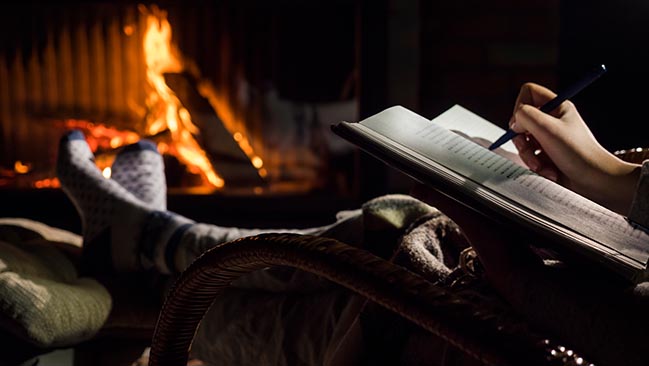
As with all the steps so far, this is impacted by length and complexity. Moving at a normal pace, each stage will naturally take 5 times longer than if the book was the length of a regular novel. There are always those test-readers who will gallop through the book in a week, but faster readers discover fewer errors, making for less helpful feedback. In the past, I’ve begun with the feedback of quick readers while waiting for the notes from the more in-depth readers who often move back and forth through the pages to check things that are worrying them. I’ve asked them to send notes in stages, so there’s no unnecessary slowdown.
The alpha stage, because it deals with a much rougher version of the manuscript, encounters far more obstacles than the beta stage. Finding problems isn’t really what takes the time, it’s addressing those problems. While typos require a few seconds each, more serious issues can involve changes that must be tracked through a thousand pages or more. I’m hoping there isn’t too much of that, but experience tells me there will be some. The alpha stage is perhaps the least predictable of the stages until all the feedback is in, but I’ll do my best to represent progress every few weeks by adjusting the bar as realistically as I can.
The beta readers will be presented with a much cleaner book and so their reading time is likely to be quicker. The editing time on beta feedback is also likely to be less than with alphas.
Trying to rush for my own personal deadline almost killed me last year, so I won’t promise dates, even to myself. I will promise, though, to work as quickly and as well as I can and to get the book into your hands the moment I believe it’s the best I can make it.
Do you have a title for the sequel?
I have a very short list and a lead contender. The trouble with making it public is that it spreads over the internet. Changing it can create a mess. I’d like to keep my options open until the artwork is done.
Does progress match your own expectations?
Not at all. I wanted it out years ago. I mentioned elsewhere that book 2 was originally meant to be shorter than book 1. It’s now twice as long as I’d planned. But when a book takes on a life of its own, stamping it down to a predetermined size is probably the worst thing a writer can do. Has it been worth the cost? Definitely! The book isn’t just longer, it has significantly more breadth, depth, and vitality than I’d foreseen when drafting it. As far as reading experiences go, I think it is the right step up from the debut.
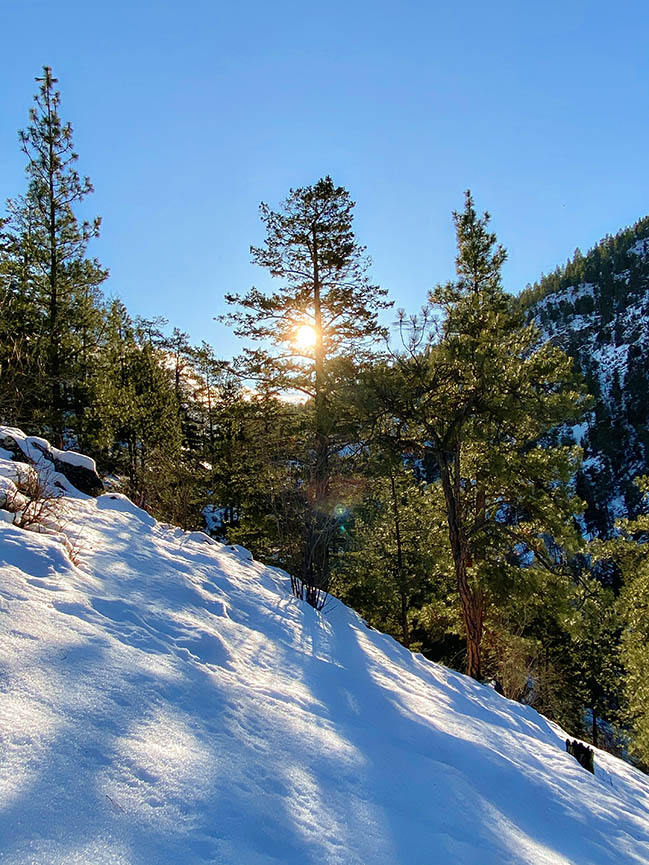
Will COVID-19 speed up progress or hinder it?
This is becoming quite a regular question, so it’s probably helpful if I answer it here. Social distancing has no influence on my speed. I’m already working as many hours a day as I can manage, and being unable to see friends – important as it is during this stage of the pandemic – doesn’t improve productivity, it just imbalances life. I certainly feel the weight of what’s happening in the world, but the distress is not paralysis.
As to the alpha readers, some have more time on their hands and some have less due to various circumstances like home schooling. But seeing as reader feedback is staggered while I work on the fixes, it probably won’t make a difference to the timeline. As to the rest of the process – audiobook recording, graphics studios, printing etc. – it’s not really possible to predict yet what the impact will be. I’m choosing to be optimistic that we’ll find ways to around the limitations without any significant lag.
In closing
I hope this answers most the most pressing questions and gives a decent idea of progress to date. At the next milestone I’ll post again. Until then, stay safe and healthy everyone. Let’s hope it’s not too long before our communities are whole again.
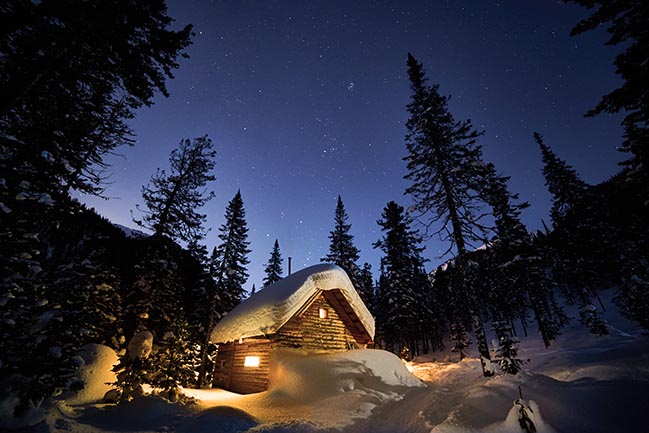

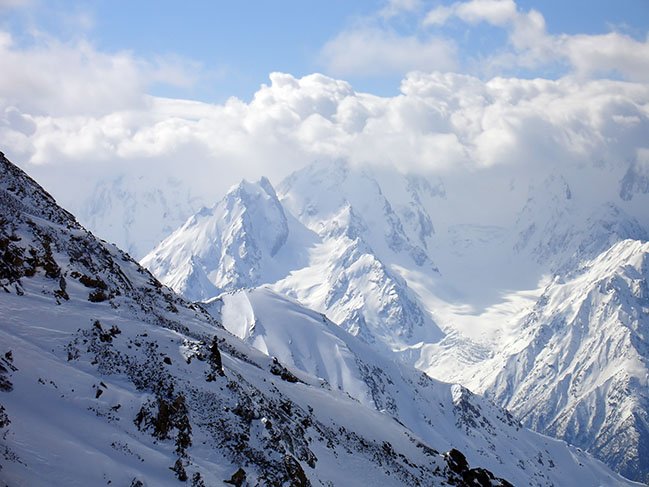
I can’t wait for the 2nd and 3rd book!!! I have listened (no time to actually sit down to read a book sadly) to Dawn of Wonder about 10 times now amd just started the 11th round! Each time I listen to it, I pick up something new. I NEED the next book!!!!! I absolutely love Dawn of Wonder! It is one of the best books I have ever listened to. It is amazing. Keep up the great and wonderful work however, your healthy and wellbeing are first and foremost! I know these next books are going to be just as amazing and I CAN’T WAIT!!!!!
Hello, I am a painter and after I read your book, I continued to listen to it on audio book while I paint. I am now reading Dawn of Wonder out loud to my 10 year old son and experiencing it all through his mind and feelings about being a boy in this crazy world. You have really captured the magic of boyhood, the energies of youth and the explosion of possibilities. Thank you so much for being your self and following your dreams and working hard to put this true work of art into the world. When I read this book to my son, we become kids together, living the magic as friends!!!!! Thank you! You are brilliant!